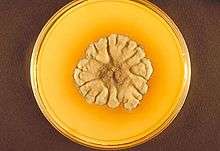Madurella grisea
Madurella grisea is a fungal species of the genus Madurella.[1] Along with Exophiala jeanselmei, Madurella grisea is one of the most common pathogenic agents associated with eumycetoma.[2]
| Madurella grisea | |
|---|---|
 | |
| Scientific classification | |
| Kingdom: | |
| Phylum: | |
| Class: | |
| Order: | |
| Family: | |
| Genus: | |
| Species: | M. grisea |
| Binomial name | |
| Madurella grisea | |
Laboratory characteristics
Colonies of Madurella grisea are slow growing, dark, leathery, and folded with radial grooves and with a light brown to greyish surface mycelium. With age, colonies become dark- to reddish-brown and acquire a brownish-black reverse. Microscopically, cultures are sterile, although hyphae of two widths have been described: thin at 1 to 3 um in width, and broad at 3 to 5 um in width. The optimum temperature of growth for M. grisea is 30C, it does not grow at 37C. RG-2 organism.
Grains of Madurella grisea (tissue microcolonies) are black, round to lobed, soft to firm, up to 1.0 mm, with two distinctive zones, a hyaline to weakly pigmented central zone and a deeply pigmented periphery.
M. grisea can be distinguished from Madurella mycetomatis by the inability to grow at 37C or assimilate lactose.
MIC data for Madurella grisea is limited. Antifungal susceptibility testing of individual strains is recommended.
Antifungal MIC ug/mL Antifungal MIC ug/mL Antifungal MIC ug/mL Range Range Range Amphotericin B 0.25 Itraconazole 0.5 Voriconazole 0.5
Clinical significance
The genus Madurella is based on tissue morphology (mycetoma with black grains) and the formation of sterile cultures on mycological media and is in need of revision. Both M. mycetomatis and M. grisea have been isolated from soil and are one of the major causative agents of mycetoma.
Mycosis: Mycetoma
References
- Vilela R, Duarte OM, Rosa CA, et al. (November 2004). "A case of eumycetoma due to Madurella grisea in northern Brazil" (PDF). Mycopathologia. 158 (4): 415–8. doi:10.1007/s11046-004-2844-y. PMID 15630550.
- Cynthia Nau Cornelissen; Bruce D. Fisher; Richard A. Harvey (eds.). Lippincott's Illustrated Reviews: Microbiologyy (3 ed.). Wolters Kluwer. p. 209.
Kwon-Chung, K.J. and J.E. Bennett. 1992. Medical Mycology. Lea & Febiger, Philadelphia and London. http://www.mycology.adelaide.edu.au/Fungal_Descriptions/Hyphomycetes_(hyaline)/Madurella/grisea.html